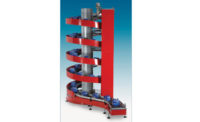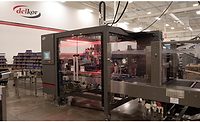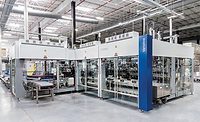![]()
Quick-change Operation
by Sarah Theodore
Creating a wide variety of products and packages has been one
of the things that makes Arizona Beverage Co. unique — something that’s great
for adventuresome consumers, but a challenge for production. The company uses
a network of co-packers to produce its beverages, and it also recently bought
a production facility of its own in Maplewood, N.J.
Located close to Newark,
Maplewood Beverage Packers produced Arizona products as a co-packer for
a number of years, but Ferolito Vultaggio & Sons purchased the
200,000-square-foot plant in August of last
year. The company brought in Plant Manager Kurt
Karaffa to oversee operations, and has focused on flexibility and quick,
efficient changeovers as a core competency.
“What attracted me to Arizona is their quality,
branding, drive of leadership and presentation,” says Karaffa.
“What we spend for packaging costs more, but I think it matches what
we have on the inside.”
In all, the plant turns out about 14 million cases of
product per year, which includes about 86 SKUs...and growing. It is not
unusual to run four to five flavors in a day, often with package changes.
“This is a boutique plant with the attitude of a
high-performance plant,” says Karaffa. “What we have
that’s unique is our flexibility to go from a pressure-sensitive
label to a sleeve label throughout the day.
There are not a lot of people who do that. We can also shrink-label
aluminum cans and that is something very few people do.
“The boutique
moniker is our flexibility, and the high-performance label is our speed and
capacity. We run 24 hours a day, seven days a week.”
Producing that many SKUs on just two production lines
has required the plant’s maintenance and operations teams to develop
specialized skills. The facility has taken on 29 new people during the past
two months, and several individuals within the plant have been selected as
experts in their areas and have been charged with leading others.
“For one guy, sleeve labels will be his
expertise, for another, cappers or pressure-sensitive labelers will be his
expertise,” says Karaffa. “With so many different machines
here, I cannot teach everybody everything, so what we do is spend a lot of
our time training one or two individuals, let them be our resident experts
and share their talent with the rest of our
employees.”
Maplewood’s nimble capabilities begin as soon as
raw materials enter the plant. Empty bottles and cans are unloaded from
trucks onto depalletizers that can quickly switch over from single-serve
glass bottles to multi-serve PET bottles to aluminum cans. The plant
devotes about 40,000 square feet of warehouse space to raw materials,
including packaging and ingredients.
Bottles and cans are
rinsed with water on their way to the filling lines, and glass bottles are
pretempered with steam to prevent hot liquid from shocking and breaking the
bottle during filling.
All products in the plant are hot-filled on one of
three fillers fed by four batching tanks. Some of the product is heated in
a tube-in-tube heat exchanger and some in a plate-and-frame heat exchanger.
Regardless of which technique is used, the liquid is heated to 195° F
and held for 20 to 25 seconds before it is cooled to 182° for filling.
The plant fills 16- and
20-ounce glass bottles, 23.5-ounce aluminum cans, and 42-ounce and 1-gallon
PET bottles. Single-serve glass bottles are filled at a rate of 600 bottles
per minute, while 42-ounce PET bottles run 275 bottles per minute. Cans are
filled at a speed of 500 per minute.
Once the packages are filled, the bottles are capped
and the can lids are sealed on. The packages are then inverted to allow the
hot liquid to sterilize the lid. An inspection system measures fill height
and rejects any partially filled bottles or miss-applied closures. The rest
of the bottles and cans are sent through a double-decker cooling tunnel
that brings the temperature down from 182° to less than 100°.
Before cooling, the hot product can be diverted to either the top cooling
deck or the bottom depending on labeling requirements (shrink-sleeve,
pressure-sensitive or pre-printed graphics).
Another inspection system on the cold side of the line
is used to test the vacuum seal on the bottles, and the packages move on to
the labelers. Some bottles and many of the cans are shrink-sleeve labeled
and some use pressure-sensitive labels. Some bottles use a combination of
pressure-sensitive and paper labels. The plant has seven labelers in all.
“Our goal is to be the world’s most diverse
beverage company from a packaging and labeling standpoint,” says
Karaffa. “This is a totally different arena dealing with sleeve
labels and pressure-sensitive labels. Most packers have preprinted cans or
are label-type limited on their application; we’re changing over the
types of labels and the types of containers.”
After labeling, the packages are date-coded and sent to
one of two multi-packers where they are cased, coded and wrapped. One of
the facility’s newest machines is a case packer that allows tooless
changeover for 12-, 15-, 18- and 24-pack case configurations in just half
an hour. The case shrink machine also is new, and does not use a sealing
bar, which Karaffa says reduces maintenance and downtime. The case overwrap
shrinks onto the package in a heat tunnel and then the cases are coded.
All along the production process, the lines are
computer monitored, analyzing the input and output of machinery. The system also has diagnostic and analytical tools to
transfer information to the case coders and UPC print-and-apply systems,
making coding changes efficient and accurate.
Products destined for shipment are palletized and
stretch-wrapped, The plant, again, has built in flexibility by using palletizers that can switch from single-serve to multi-serve pallets when necessary.
Some of the products take a detour on their way out of
the plant to a “work in progress” area where variety packs are
assembled for club stores. Single-variety cases are taken apart and
repackaged as mixed cases. Although the process is manually dependent and
semi-automatic, it saves money to put together the variety packs in house
rather than outsource the process to a third-party repacker, says Karaffa.
Most of the product produced at the Maplewood plant is
stored in an adjacent finished product warehouse that has a capacity of
700,000 cases. Only product for local distribution is warehoused in the
main plant, and the company also holds in reserve some of its
biggest-selling black and green teas. The main production facility houses
seven truck bays for shipping.
In addition to its own QA/QC lab that monitors
production, the company works with its flavor supplier to test product
quality. The lines are cleaned between flavors as well as changes from diet
to sugared products, and the plant runs products in a hierarchy from light
to dark colors to enable faster changeovers.
Because of its close proximity to the Arizona Beverage Co. headquarters and the reputation for flexibility the
plant is developing, Karaffa says the Maplewood plant is often used as a
test plant for new ideas.
“That’s the boutique, high-performance
label we live with,” he says. “But that’s OK, because we
want to get to the point where we can bring co-packers in here and show
them how we do it.”
And for all the changes that have taken place during
the past year, more are still in store. The company already has outgrown
its current space and is making plans to move
production to a new facility in Perth Amboy, N.J., in just a few years.
It’s hoping to take its newly trained team of experts and flexible,
quick-change attitude to the new facility where even more new ideas can come to fruition. BI
Plant within a plant
Arizona Beverage’s
Maplewood, N.J., plant houses an unexpected surprise for a beverage plant
— it has a food production area where Arizona-branded chips and dip
are produced.
Company Chairman Don Vultaggio says he was inspired to
produce the snacks when he saw another brand of chips and dip at a movie
theater and thought the product would complement its beverage products for
convenience store customers.
“It’s what c-stores are about —
salty snacks, drinks and candy,” he says.
The shelf-stable products are assembled in a special
area where the cheese is heated, combined in a package with the chips and
sealed in an oxygen-free environment.
Vultaggio describes the package as
“bullet-proof.” The container is made of polypropylene, and the
lid is metalized, protecting it from oxygen and UV rays, and giving it a
minimum shelf life of nine months, compared with a little more than a month
for bagged chips.


